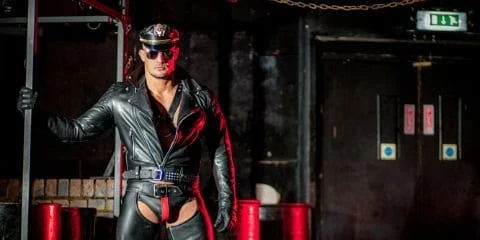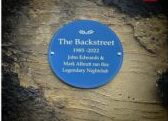
The gay leather scene largely emerged in the US after the Second World War, when returning servicemen wanted to re-create the tough single sex conditions they had been exposed to during active service. Taking inspiration from both the military as well as Californian leather biker culture, the scene grew quickly in large American cities, notably New York, LA, Chicago and San Francisco where many ex-military men relocated. 1953’s The Wild One, starring Marlon Brando increased the visibility of leather bikers, as did the work of iconic illustrator/artist Tom of Finland. In the late 1950’s certain bars became the haunts of the leather community, becoming dedicated queer leather bars as the scene’s popularity grew.
 The 1970’s were the heyday of the gay leather scene and most larger western cities sported a leather bar, creating an unofficial network and home for anyone in the community. In Europe, Amsterdam, Berlin and Hamburg all offered a good time to leather men. London’s gay leather scene was smaller, but still energetic. The first gay motorcycle club, The 69 Club, opened in 1965, but it was The Coleherne in Earls Court which became the main home to London’s leather community in the 1970’s.
The 1970’s were the heyday of the gay leather scene and most larger western cities sported a leather bar, creating an unofficial network and home for anyone in the community. In Europe, Amsterdam, Berlin and Hamburg all offered a good time to leather men. London’s gay leather scene was smaller, but still energetic. The first gay motorcycle club, The 69 Club, opened in 1965, but it was The Coleherne in Earls Court which became the main home to London’s leather community in the 1970’s.
London’s longest running gay leather/rubber bar, The Backstreet, in Mile End, opened in 1985, and was open for 37 years until it closed in 2022. The Backstreet, a new documentary by director Romain Beck, takes us on an intimate, candid, trip through four decades of its life, leather, lust and loss, told through the eyes of its founder, John Edwards, long time barman Mark Allnutt, and many of its regulars. What emerges is a heartfelt chronicle of a unique space in London’s queer scene – a sanctuary full of warmth, community, friendship and leather-bound sex. Beck was given unique access to film the 2022 closing party of The Backstreet – the only footage that exists of a night at the self-contained space. This was attended by over 200 regulars, dressed in their finest, and many recall tales of community, sex and desire, the AIDS years, and memories of the characters who were the fabric of the bar. We learn of the meticulous attention to detail, in both the interior of the bar – the boots hanging from the ceiling, the cage, dim red lighting, the black walls and chains as well as the details on the outfits of its patrons. Erotic footage is combined with a compelling soundtrack. You can almost feel and smell the leather. The resulting legacy, combined with re-enacted scenarios, is rich and compelling, making you wish you’d been there, or spent more time there. Thoughtful, sensitive story-telling.
Screening 19th September at London’s Genesis Cinema as part of the Fringe Queer Film & Arts Fest.
Queerguru’s Contributing Editor Ris Fatah is a successful fashion/luxury business consultant (when he can be bothered) who divides and wastes his time between London and Ibiza. He is a lover of all things queer, feminist, and human rights in general. @ris.fatah

